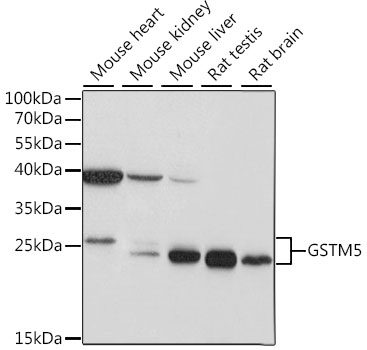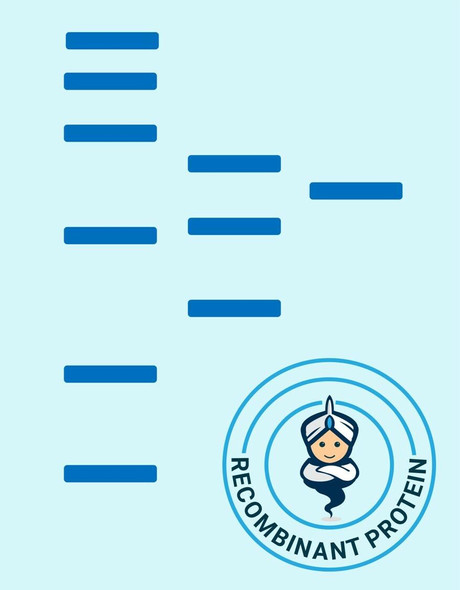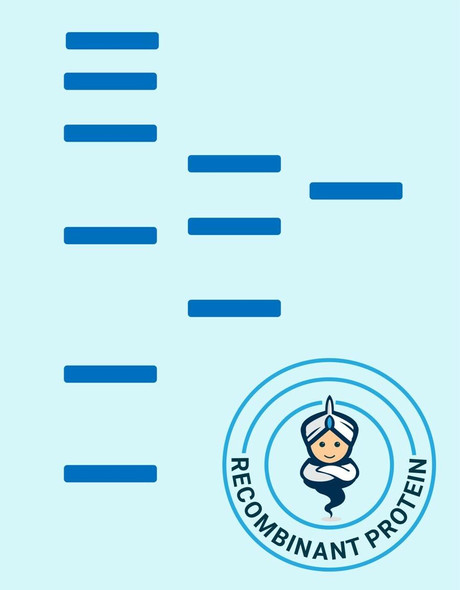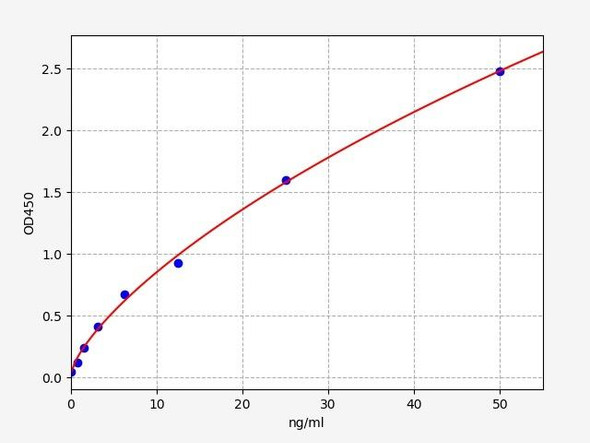Cell Biology Antibodies 6
Anti-GSTM5 Antibody (CAB15677)
- SKU:
- CAB15677
- Product Type:
- Antibody
- Reactivity:
- Mouse
- Reactivity:
- Rat
- Host Species:
- Rabbit
- Isotype:
- IgG
- Antibody Type:
- Polyclonal Antibody
- Research Area:
- Cell Biology
Description
| Antibody Name: | Anti-GSTM5 Antibody |
| Antibody SKU: | CAB15677 |
| Antibody Size: | 20uL, 50uL, 100uL |
| Application: | WB IF |
| Reactivity: | Mouse, Rat |
| Host Species: | Rabbit |
| Immunogen: | A synthetic peptide corresponding to a sequence within amino acids 100 to the C-terminus of human GSTM5 (NP_000842.2). |
| Application: | WB IF |
| Recommended Dilution: | WB 1:500 - 1:2000 IF 1:50 - 1:100 |
| Reactivity: | Mouse, Rat |
| Positive Samples: | Mouse heart, Mouse kidney, Mouse liver, Rat testis, Rat brain |
| Immunogen: | A synthetic peptide corresponding to a sequence within amino acids 100 to the C-terminus of human GSTM5 (NP_000842.2). |
| Purification Method: | Affinity purification |
| Storage Buffer: | Store at -20'C. Avoid freeze / thaw cycles. Buffer: PBS with 0.02% sodium azide, 50% glycerol, pH7.3. |
| Isotype: | IgG |
| Sequence: | LENQ VMDN HMEL VRLC YDPD FEKL KPKY LEEL PEKL KLYS EFLG KRPW FAGD KITF VDFL AYDV LDMK RIFE PKCL DAFL NLKD FISR FEGL KKIS AYMK SSQF LRGL LFGK SATW NSK |
| Gene ID: | 2949 |
| Uniprot: | P46439 |
| Cellular Location: | Cytoplasm |
| Calculated MW: | 25kDa |
| Observed MW: | 24-26kDa |
| Synonyms: | GSTM5, GSTM5-5, GTM5 |
| Background: | Cytosolic and membrane-bound forms of glutathione S-transferase are encoded by two distinct supergene families. At present, eight distinct classes of the soluble cytoplasmic mammalian glutathione S-transferases have been identified: alpha, kappa, mu, omega, pi, sigma, theta and zeta. This gene encodes a glutathione S-transferase that belongs to the mu class. The mu class of enzymes functions in the detoxification of electrophilic compounds, including carcinogens, therapeutic drugs, environmental toxins and products of oxidative stress, by conjugation with glutathione. The genes encoding the mu class of enzymes are organized in a gene cluster on chromosome 1p13.3 and are known to be highly polymorphic. These genetic variations can change an individual's susceptibility to carcinogens and toxins as well as affect the toxicity and efficacy of certain drugs. Diversification of these genes has occurred in regions encoding substrate-binding domains, as well as in tissue expression patterns, to accommodate an increasing number of foreign compounds. |
| UniProt Protein Function: | GSTM5: Conjugation of reduced glutathione to a wide number of exogenous and endogenous hydrophobic electrophiles. Belongs to the GST superfamily. Mu family. |
| UniProt Protein Details: | Protein type:Xenobiotic Metabolism - drug metabolism - cytochrome P450; Xenobiotic Metabolism - metabolism by cytochrome P450; Transferase; Other Amino Acids Metabolism - glutathione; EC 2.5.1.18 Chromosomal Location of Human Ortholog: 1p13.3 Cellular Component: cytosol Molecular Function:glutathione transferase activity; protein binding Biological Process: glutathione metabolic process |
| NCBI Summary: | Cytosolic and membrane-bound forms of glutathione S-transferase are encoded by two distinct supergene families. At present, eight distinct classes of the soluble cytoplasmic mammalian glutathione S-transferases have been identified: alpha, kappa, mu, omega, pi, sigma, theta and zeta. This gene encodes a glutathione S-transferase that belongs to the mu class. The mu class of enzymes functions in the detoxification of electrophilic compounds, including carcinogens, therapeutic drugs, environmental toxins and products of oxidative stress, by conjugation with glutathione. The genes encoding the mu class of enzymes are organized in a gene cluster on chromosome 1p13.3 and are known to be highly polymorphic. These genetic variations can change an individual's susceptibility to carcinogens and toxins as well as affect the toxicity and efficacy of certain drugs. Diversification of these genes has occurred in regions encoding substrate-binding domains, as well as in tissue expression patterns, to accommodate an increasing number of foreign compounds. [provided by RefSeq, Jul 2008] |
| UniProt Code: | P46439 |
| NCBI GenInfo Identifier: | 67476963 |
| NCBI Gene ID: | 2949 |
| NCBI Accession: | P46439.3 |
| UniProt Secondary Accession: | P46439,Q6PD78, A8K0V8, |
| UniProt Related Accession: | P46439 |
| Molecular Weight: | 25,675 Da |
| NCBI Full Name: | Glutathione S-transferase Mu 5 |
| NCBI Synonym Full Names: | glutathione S-transferase mu 5 |
| NCBI Official Symbol: | GSTM5 |
| NCBI Official Synonym Symbols: | GTM5; GSTM5-5 |
| NCBI Protein Information: | glutathione S-transferase Mu 5 |
| UniProt Protein Name: | Glutathione S-transferase Mu 5 |
| UniProt Synonym Protein Names: | GST class-mu 5; GSTM5-5 |
| Protein Family: | Glutathione S-transferase |
| UniProt Gene Name: | GSTM5 |
| UniProt Entry Name: | GSTM5_HUMAN |
View AllClose







